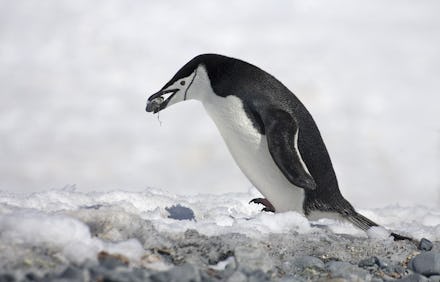Climate change is putting the chinstrap penguin's future at risk

The threats of climate change are not limited to areas where humans live. Isolated regions like Antartica are feeling some of the harshest effects and it's harming the animals who make their homes there. In the past few decades, the population of chinstrap penguins has dramatically fallen thanks to climate change.
You may not be super familiar with chinstrap penguins but they're hardy creatures. You have to be in order to survive in Antartica. According to National Geographic, chinstraps are the most abundant penguin in Antartica, where they're also known for their rock-climbing abilities.
However, chinstraps are no longer as abundant as they once were. Researchers counting the number of chinstraps in the Antarctic Peninsula this year realized that the penguins were disappearing, in some cases with population reductions as high as 77 percent, Time reported.
It's hard to conduct surveys of chinstraps because they live in remote locations that can be extremely difficult to access. The last census took place in 1971 on Elephant Island in the Southern Ocean. Researchers returned to the island to survey 32 colonies and each one saw a decline. Overall, Time reported that the population dropped from 122,550 breeding pairs in 1971 to 52,786 in January 2020.
"Such significant declines suggest that the Southern Ocean’s ecosystem is fundamentally changed from 50 years ago, and that the impacts of this are rippling up the food web to species like chinstrap penguins,” Heather J. Lynch, associate professor of ecology & evolution at Stony Brook University in upstate New York, told Time.
Like many other species, chinstrap penguins rely on krill, the keystone of the Antarctic marine food chain, but their food source is fading. In 2016, one study found that krill have declined by up to 80 percent in some Antarctic seas. In 2018, researchers warned that krill's decline could lead to penguin populations dropping by almost a third.
Chinstraps aren't the only penguins at risk. The well-known Emperor Penguins could end up extinct because of disappearing sea ice and other impacts of climate change. Associate scientist Stephanie Jenouvrier compared Emperor Penguins to canaries in the coal mine.
"Although they are found in Antarctica, far from human civilization, they live in such delicate balance with their rapidly changing environment that they have become modern-day canaries," Jenouvrier wrote.
As a whole, the Antarctic Peninsula is seeing a lot of changes, including rapid heating that's melting glaciers. Just last week, temperatures there reached 65 degrees. The falling population of chinstraps — and other penguins — in the region are a warning. It doesn't matter how remote an area is, the disastrous impacts of climate change will grow if the countries responsible don't change.